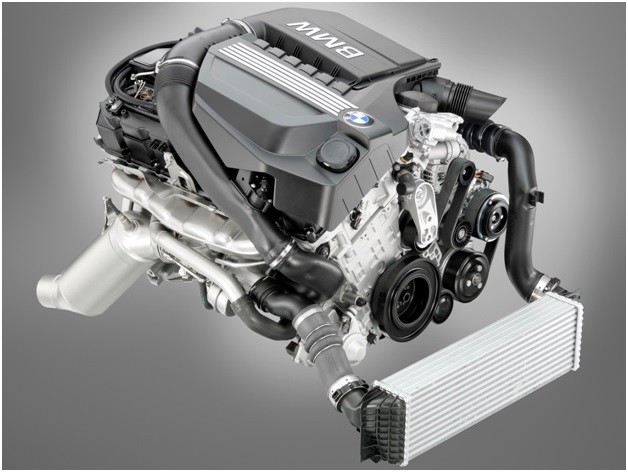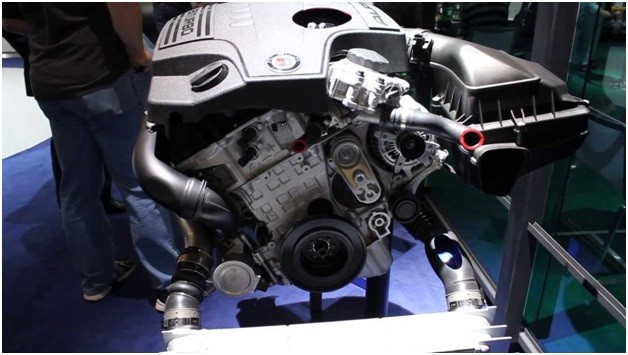
BMW N55, N55B30, N55B30M0 engines
BMW N55B30 - 6-cylinder engine equipped with two camshafts (DOHC system), turbocharging and direct fuel injection. It began to be produced in 2009 and today, in the middle of 2018, some of its modifications are still produced by the Munich Plant
One of the modifications is made by Alpina. This engine has replaced the N54 series. According to the manufacturer, it is more environmentally friendly and 15% more efficient than its predecessors N53 and N54. And although the volume of emissions of harmful substances into the atmosphere is of little concern to buyers, it is impossible to sell engines in different countries without this.
Features
Munich Plant engine parameters are shown in the table:
| Exact volume | 2.979 l. |
|---|---|
| Cylinder block | Aluminum |
| Supply system | Injector |
| Number of cylinders | 6 |
| Number of valves | 4 per cylinder, total - 24 |
| Piston stroke | 89.6 mm. |
| Bore | 84 mm. |
| Compression ratio | 10.02.2019 |
| Power (depending on modification) | 306-370 h.p. |
| Torque (depending on modification) | 400-465 Nm. |
| Required fuel | Gasoline AI-95 |
| Fuel consumption per 100 km. | Around the garden - up to 11.6 l. On the highway - up to 6.5 liters. |
| Required oil viscosity | 5W-30, 5W-40 |
| Engine oil volume | 6.5 l. |
| Possible oil consumption | 700 ml. /1000 km. |
| Relubrication through | 10000 km, better - after 7-8 thousand km. |
| Normal working temperature | Since 110 |
| Resource | 200 thousand km. before overhaul |
| Tuning | Up to 400 hp |
In 2009, the engine was introduced as part of the VMW 535i GT. The loan was also put on other models:
- 135
- 235
- 335
- 435
- 535
- X1 35i
- X3 35i
- X4 35i
- 640
- 740
- X5 35i
- X5 40i
- X6 35i.
The N55B30 is a universal motor that can be installed on various types of cars - from light sports coupes to massive and heavy SUVs.
Design features
The unit received a completely aluminum cylinder block, inside it - liners made of gray cast iron GGG70. This is a durable metal, from which crankshafts are also made. This increases the service life of the unit and its ability to absorb high loads. They also cool perfectly thanks to additional channels for the movement of coolant. Compared to its predecessor N54, the new engine has an improved cooling system, and oil return to the sump from the cylinder head is also provided.
Kolenvan - lightweight. It weighs only 20.3 kg, which is 3 kg less than its predecessor N54. The connecting rods and pistons have also changed. The timing system has been improved (Bi-Vanos), as has the Valvetronic III valve lift control system.
Unlike the previous engine, one Borg Warner B03 turbocharger with a boost pressure of 0.65 bar is installed here.
Control system - Bosch MEVD 172x with Infineon TriCore processors, guaranteeing high speed. The N55 also features HDEV5.2 high-pressure solenoid injectors for pressures up to 200 bar. Unlike standard ones, they have many holes for changing the shape and angle of fuel spray in the combustion chamber.
The new N55B30 engine implements the latest achievements in the field of gas distribution systems, mixture formation. It has an improved Double VANOS system (on both shafts) for adjusting the position of the camshafts, VALVETRONIC technology that controls the stroke of the intake valves, and direct fuel injection.
The joint work of these systems received the abbreviation TVDI, which means Turbo-Valvetronic-Direct-Injection. Together with a turbocharger, the system is able to regulate the local fuel ignition zones in the cylinders and the degree of gasoline enrichment. All this leads to fuel economy - this is noticeable even by the technical characteristics: 6.5 liters of gasoline per 100 km on the highway is an excellent result for a 3-liter gasoline engine. Not all diesel power plants can boast of such a result.
Modifications
Like all successful engines, the N55B30 received different versions, differing in design features and, therefore, power.
- N55B30M0 - basic modification with a power of 306 hp. and a torque of 400 Nm. It is put on cars with index 35i.
- N55 - produced since 2010, its power reaches 320 hp; torque - 450 Nm. Compared to the previous version, the firmware and cooling system have been improved here. You can find it on BMW cars with the index 35i and 40i.
- N55B30O0 - has been produced since 2011 and is an analogue of the N55, but with an increase of 6 hp.
- N55HP - 340 hp engine with 450 Nm of torque. With "Overboost", the torque rises to 500 Nm. Found on 35i vehicles from 2015.
- N55B30T0 - 360-horsepower unit with a torque of 465 Nm. The version was developed for BMW with the 40i index.
- Another N55B30O0 is the most powerful motor (370 hp) with a torque of 465 Nm (500 Nm with Overboost). This engine is for the M series sports cars. Installed from 2015 to the present.
Add to this that there are two BMW N55 engines. One is produced by BMW itself, the other by Aplina. There are no serious fundamental differences between them, but there are some constructive ones. The Alpina engine has 2 separate turbochargers, which are left over from the previous version of the N54. Also here are pistons with a thicker bottom. Plus, there are differences associated with the adaptation of the motor to two superchargers. Also, Alpina engineers paid more attention to the cooling of the motor, which is logical given its higher power.
Engine changes led to the need to use a different automatic transmission, designed for higher power and torque of the power plant.
Problems
In 2014, the N55 was recognized as the best engine with a volume of 2.5-3 liters, but this does not mean that it does not have problems. The following can be distinguished:
- Increased oil consumption. The reason is banal - crankcase ventilation valve. It should be checked and replaced.
- Misfiring is a common problem with these engines, caused by coked hydraulic lifters. To prevent this from happening, experts advise filling in normal original oil, and not cheap fakes. Some car owners note that they have had misfires due to a weak battery, which can also be the cause.
- Vibrations - with a high degree of probability, the high pressure nozzles failed. Their service life is 80-100 thousand km. After replacement, the engine runs normally again.
- High pressure fuel pump - "dies" from time to time. It also has to be changed and continue to pour high-quality fuel. Note that in Russia the quality of gasoline is not of the highest quality, and all engines with direct injection are extremely demanding on gasoline. Therefore, most experienced drivers in our country are afraid of such motors, since a breakdown of a high-pressure fuel pump (or another element of the system) is a matter of time, and repairs are very expensive.
In general, the BMW N55B30 engine loves good oils and fuels, so the choice of fuels and lubricants should be approached responsibly. With normal maintenance, the N55B30 motor will travel 100-150 thousand without the slightest problem (perhaps more), and then it will need to be finalized. The engine has room for tuning and is generally a good choice as a contract engine.
By the way, by the state of the varnish under the valve cover cap, you can determine the current state of the internal combustion engine. The first sign of bad health is a red-brown varnish under the cap, which is easy to wipe off. If there is already brown sand under it (along the perimeter), then this is already bad - it is advisable to diagnose the engine at the service station. The final stages of the disease are sand over the entire surface of the lid, in the worst case, oily "jelly".
Tuning
By changing the software settings, you can increase the power to 360-380 hp. while the engine resource will be fully preserved. That is, the N55B30 is simply chipped - on the JB4 Stage 2 firmware it will be able to produce 360 hp, and if you put a cold intake and a sports exhaust, then the power will rise to 380 hp.
The only problem is the complexity of installing the firmware. On this engine, it cannot be “filled in” through the OBD II connector. You have to dismantle the control unit, activate the Boot mode, and only then download the program. The difficulty is that the control unit itself is hidden, and in order to get to it, you have to remove the intake manifold. All this turns into a laborious process and costs the car owner dearly. However, at this stage, the wire for activating Boot can be brought into the cabin, which in the future will allow you to “fill in” the firmware without removing the intake manifold.
Alpina has shown what the N55B30 engine is really capable of. By putting 2 turbo compressors on it, the engineers were able to increase power to 410 hp, torque to 600 Nm. Therefore, the potential for tuning the "serial" N55 from the "BMW" itself is huge. However, when bringing the serial engine to such power, it may be necessary to replace the automatic transmission, since the stock box is not designed for such a high torque, although in practice it can withstand it.
Contract engines
Taking into account the fact that various modifications of the N55B30 engine are still being made to this day, it will be easy to find a "contractor". Moreover, they are available in a wide price range, and the final cost depends on the year of manufacture, the availability of attachments, mileage, etc.
At different sites, prices for these engines can vary in the range of 200-400 thousand rubles. It may be possible to find cheap "killed" copies that will be used for spare parts.
Judging by the offers of sellers, a normal "live" engine in a new state can be "taken" for 380 thousand rubles.
Recommendations for purchasing a motor are standard: the newer, the better. It should be borne in mind that the first N55B30 motors began to be produced in 2009, so today they are already 8-9 years old. During this period, the resource of any engine can be used up, therefore, when choosing a contract ICE, preference should be given to models made in 2015 and younger. Otherwise, there is a high risk of taking a motor with high mileage and a major overhaul, although in some cases this is even good. Choosing a fresh engine manufactured in 2015 and newer, you can count on 100-200 thousand km. mileage, although there are no guarantees.
Conclusion
The BMW N55B30 is not a miracle of modern engineering, but definitely a cool technological engine from a reliable German concern. It is powerful, with high torque at low and high speeds, has a long resource, subject to normal maintenance according to the data sheet. Modern technologies such as Valvetronic and Doble-VANOS increase its performance, contribute to fuel economy, so these internal combustion engines will not become obsolete in the next 3-4 years. The fact that they began to be produced in 2009, and for 9 years the concern has not refused them, speaks of their high quality and compliance with modern requirements.
Definitely, cars based on the N55B30 are recommended for purchase, but when choosing used cars, you should take the choice seriously and consider the engine from all sides, ideally from the inside.

